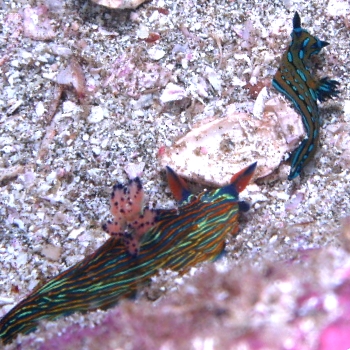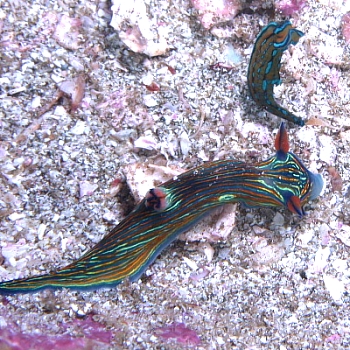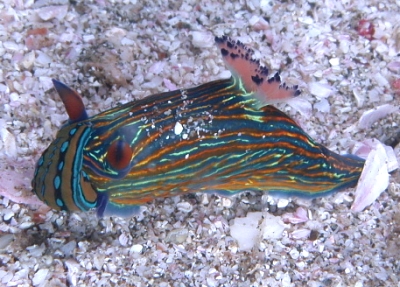Roboastra leonis - Feeding behaviour
July 26, 2007
From: Alicia Hermosillo


Concerning message #20283:
Dear Bill,
We observe similar behaviors on our side of the Pacific Ocean as well. We have two species of Roboastra: R. tigris and R. leonis (very appropiate!) and they do not overlap in range. R. tigris is known within the Gulf of California to Bahia de Banderas) and R. leonis from Costa Rica and the Galapagos, the gap in between needs more study to determine how far they are distributed.
In all this range, we have two of their preferred prey: Tambja abdere and Tambja eliora. They seem to like T. eliora more, since I have seen them spit out T. abdere more often than not. Now, T. eliora also has the swimming response observed by Graham in Tambja morosa, and I have seen it do so as soon as the Roboastra touches it. I have not seen it react to the mucus trail as Tambja morosa does, but it is certainly an interesting notion. I think this series of photos illustrates the escape response (attempt) of T. eliora to an attack by R. leonis.
Locality: Islas Murcielago, 36 feet, Costa Rica, tropical eastern Pacific, 3 July 2005, Rocky reef. Length: 29 mm. Photographer: Alicia Hermosillo.
Kind regards,
Ali
gueri25@hotmail.com
Hermosillo, A., 2007 (Jul 26) Roboastra leonis - Feeding behaviour. [Message in] Sea Slug Forum. Australian Museum, Sydney. Available from http://www.seaslugforum.net/find/20302
Dear Ali,
I thought this story had a happy ending for the Tambja until I saw its 'tail' flapping in the mouth of Roboastra in the photo alongside.
Your mention of an apparent preference for T. eliora is interesting as it fits the work of the chemical ecologists Carté and Faulkner (1983, 1986). Tambja eliora and T. abdere both feed on the bryozoan Sessibugula translucens which produce a whole suite of antifeedant chemicals including a group of molecules which have been given the name tambjamines for obvious reasons. Both species of Tambja retain these antifeedant chemicals in their skin. Carté and Faulkner studied Roboastra tigris feeding on these two species of Tambja and found that when attacked, T. abdere exuded copious quantities of a yellow mucus containing up to 3 mg of the tambjamines which was usually enough to deter the Roboastra. However they found that R. eliora, because of its smaller size, contained less than 2 mg of the tambjamines in its body so could not exude a strong enough deterrent dose of the tambjamines no matter how hard it tried, so to escape being eaten by Roboastra it relied on its swimming behaviour to escape.
Your observations fit this scenario perfectly and well illustrate how important it is for us to understand the food choices, and the resulting chemistry, when trying to interpret the behaviour and ecology of opisthobranchs.
-
Carté, B. and Faulkner, D. J. (1983) Defensive metabolites from three Nembrothid nudibranchs. Journal of Organic Chemistry, 48: 2314-2318.
-
Carté, B. and Faulkner, D. J. (1986) Role of secondary metabolites in feeding associations between a predatory nudibranch, two grazing nudibranchs, and a bryozoan. Journal of Chemical Ecology, 12: 795-804.
Best wishes,
Bill Rudman
Related messages
-
Roboastra leonis from the eastern Pacific
From: Bill Rudman, July 22, 2005 -
Re: Roboastra tigris? from Galapagos
From: Ray Simpson, January 25, 2004 -
Roboastra tigris? from Galapagos
From: Patty Dilworth, January 23, 2004
